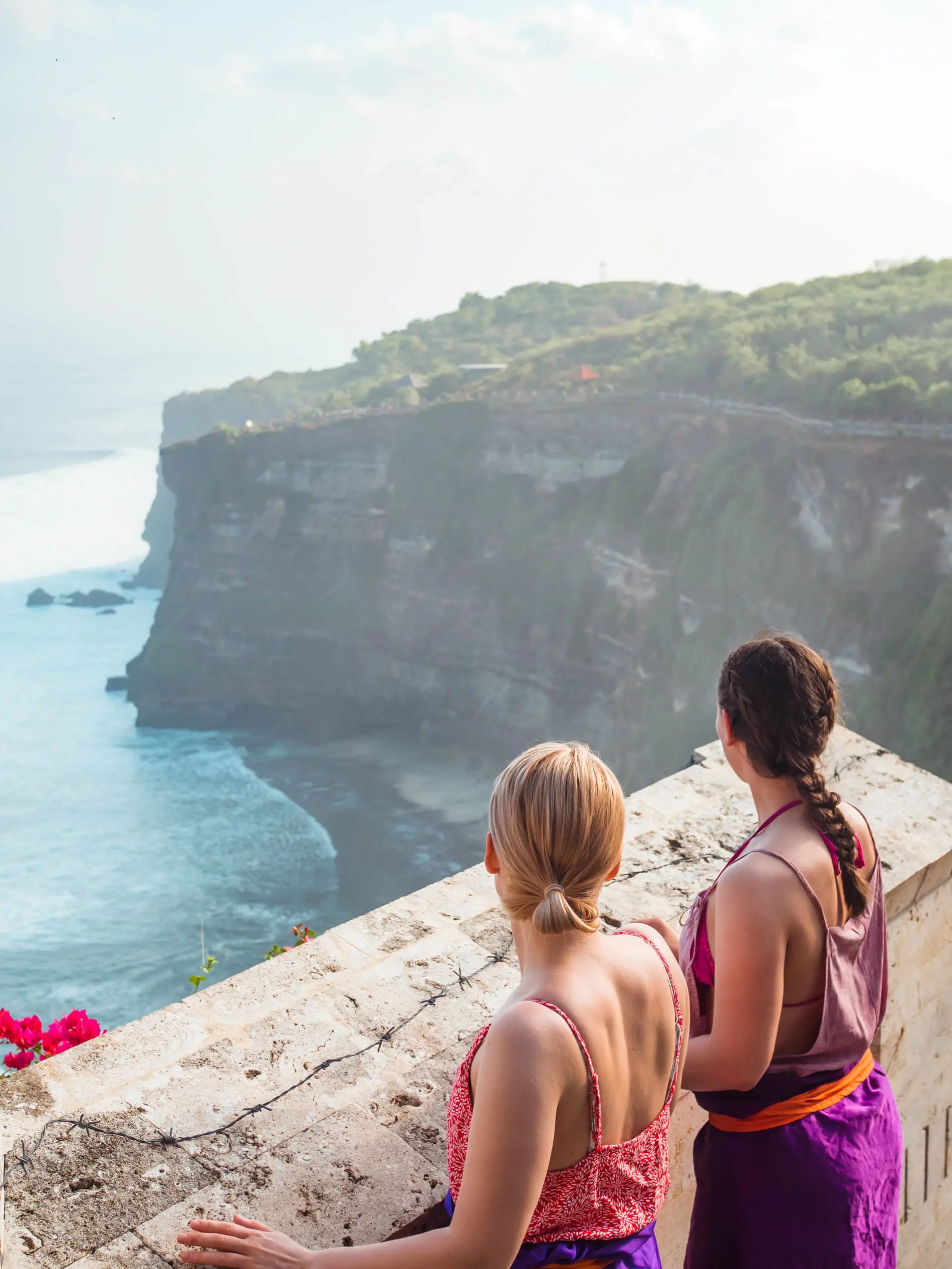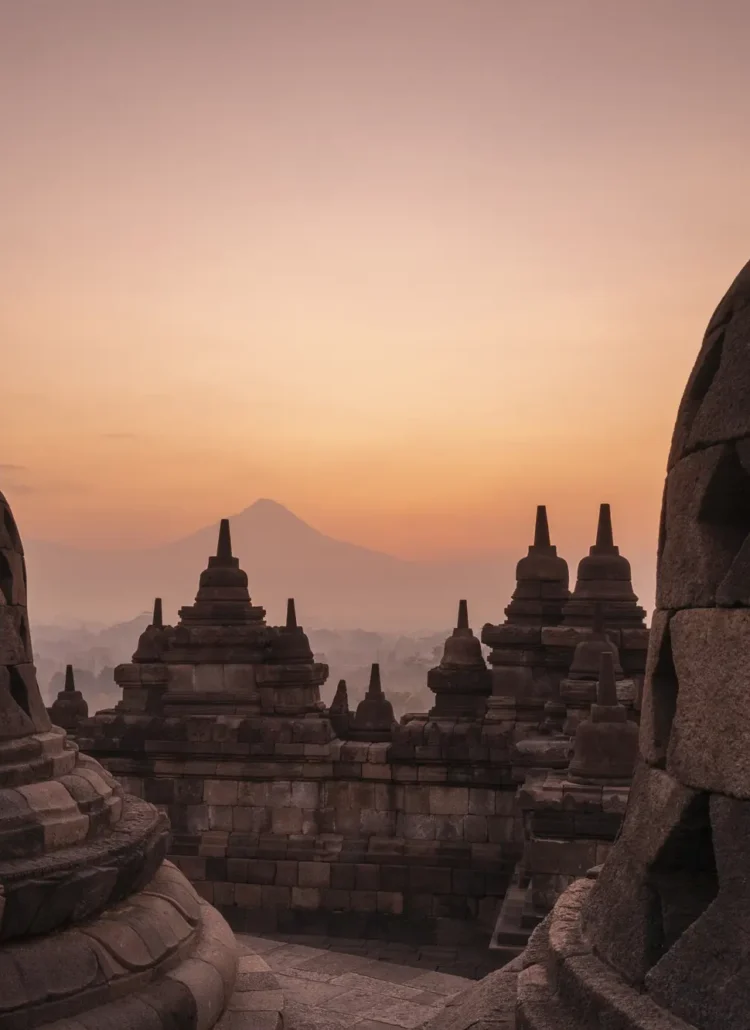I have been to the Uluwatu Temple, or Pura Luhur Uluwatu, in Bali more than any other attraction on the island, probably 10+ times. There is just something magical about it, especially early in the morning.
Perched atop a cliff, 70 meters above the waves of the Indian Ocean, Uluwatu Temple is one of Bali’s six key temples and a significant spiritual pillar.
In this guide, we’ll take a look at how to get to the Uluwatu Temple, what to expect, how to stay safe around the monkeys and the best time to visit.



Article overview
Is Uluwatu Temple worth visiting?
YEEES! Uluwatu Temple is definitely worth visiting, it is up there with my two other favorite temples in Bali, Gunung Kawi and Pura Lempuyang.
I have seen a lot of reviews from people hating their visit lately, which is probably because they got there in the middle of the day when it is hot, VERY crowded and the monkeys are aggressive.
For me, it is one of the first places I always bring my friends and family, here are a few reasons why:
- Significance: Uluwatu Temple is one of Bali’s six key spiritual pillars and a significant sea temple, playing an important role in the island’s religious life.
- Location: Perched on a dramatic cliff 70 meters above the Indian Ocean, the temple boasts breathtaking views that are particularly beautiful early in the morning and at sunset.
- Architectural beauty: The traditional Balinese architecture, sculptures and gateways, some dating back to the 11th and 16th centuries, made from coral rock. are stunning and create a magical, ancient spiritual feeling.
- Traditional dance: The temple itself isn’t the only attraction. You can also watch a Kecak fire dance performed by locals, set against the sunset backdrop.
- Monkeys: The temple is home to a large population of monkeys, which, while mischievous, also add to the fun experience.
- Photo ops: With its impressive location, endless flowers and ornate elements, Uluwatu Temple is a photographer’s dream.


Quick history
Uluwatu Temple is considered one of the six spiritual pillars of Bali, known as the Sad Kahyangan Temples. These six temples are strategically positioned across the island to provide spiritual balance and protection.
Uluwatu Temple specifically guards Bali from evil sea spirits. The temple’s location at the edge of a high cliff represents the Hindu belief in the balance between the spiritual and the natural world.
The oldest parts of the temple are the main shrine and its imposing stone gate carved with intricate floral designs, dating back to the 10th century. It is built predominantly from locally sourced coral stone, which gives it a distinctive color and appearance.
Later, in the 16th century, Dang Hyang Nirartha, further developed the temple complex during his travels through Bali to spread Hinduism. He is said to have attained Moksha here, the freedom from the eternal cycle of life, death, and rebirth.

How to get to Uluwatu Temple
As you know if you have read my 2-week Bali itinerary, I highly recommend you spend at least a few nights in Uluwatu. This is my favorite area and where you’ll find all the best beaches in Bali. See this guide for where to stay in Uluwatu.
Uluwatu Temple doesn’t have an official address but is located on the main road running along the coast. Take a right where Jl. Pantai Suluban turns into Jl. Raya Uluwatu. You’ll see the security post where you pay for parking immediately.
If you’re driving from the main Uluwatu/Padang Padang area, it takes about 5 minutes to reach the temple. From Seminyak and Legian, expect to spend 1.5 hours on the road, and from Ubud, around 2.5 hours.
By scooter
Uluwatu is one of the areas in Bali where I love to drive by myself. There’s only one main road running along the coast, and traffic doesn’t get too crazy.
You can easily ask your accommodation to arrange a scooter for you, or motorbike as the locals call them. It usually costs around 75.000 IDR a day.
Just make sure your travel insurance covers you and look out for scams run by both the police and renters. Read more in my article about common scams in Bali and things NOT to do in Bali.
Scooter delivery
Get a scooter delivered to your hotel or homestay. That way you don’t run the risk of being told that there are no more scooters available. It doesn’t get more convenient.
🌟 Check price and availability here >> Scooter rental with delivery
With a private driver
Something you will quickly realize is that everyone in Bali knows a driver. You can ask your accommodation to arrange one for you or just find one on the street.
I, however, like to arrange my driver online so I can pay in advance and have someone to complain to if something goes wrong. Haha. I often book the driver below.
How much does a private driver in Bali cost? It depends on the season, type of vehicle, location and duration. In the main tourist hubs of Ubud/Canggu/Seminyak expect to pay more than in say North or East Bali. 45 USD (750k IDR) is the cheapest driver I have found lately for 10 hours and unlimited mileage.
Best Uluwatu Temple tours
If you don’t feel like driving a scooter by yourself, you can join a guided tour. I have done all the research for you, here is the best value tours including Uluwatu Temple and Kecak Fire Dance.

🔥 ULUWATU TEMPLE + KECAK DANCE
- Hotel pick-up and drop-off.
- Tickets to the temple and Kecak Fire Dance.
- Time to explore the temple and watch the monkeys.

🐚 ULUWATU BEACHES + TEMPLE
- Visit Melasti, Padang Padang and Suluban Beach.
- Explore Uluwatu temple and watch Kecak Dance.
- Enjoy a seafood dinner in Jimbaran Bay.


Things to know before you visit
Here are the things you should know before visiting Uluwatu Temple, a little planning is necessary.
Best time to visit
The ideal time to visit Uluwatu Temple is generally considered to be the dry season, from April to October. My favorite time to visit Bali, however, is from February to April, when everything is green after the rainy season and the crowds are smaller.
Early mornings and sunsets are particularly stunning for views and photography. The tour buses usually roll in around 9:00 am, so I like to get there right at opening. Just keep in mind that the monkeys will not have woken up yet.
Opening hours
Uluwatu Temple is open daily from 7:00 am to 6:00 pm for visitors.
The main temple/shrine is accessible during prayer time for worship purposes only.
Entrance fee
Here you can see the current entrance fees at Uluwatu Temple.
| Category | Price (IDR) |
|---|---|
| Adult | 60,000 |
| Child | 30,000 |
| Local | 30/15,000 |
| Kecak dance | 150,000 |
| Parking | 5,000 |
| Sarong rental | Included |
What to wear
When visiting Uluwatu Temple in Bali, it’s important to dress respectfully as it is a place of worship. Here’s what you should consider:
- Clothing: Wear modest clothing that covers your knees. I have never been asked to cover my shoulders, but during my last few visits, I have worn a T-shirt just in case.
- Sarong and sash: All visitors are required to wear a sarong and a sash around the waist. Both are provided at the temple entrance if you don’t have your own.
- Footwear: If you plan on walking the entire temple complex, comfortable walking shoes are recommended as there are steps and uneven surfaces. I always wear my flip-flops, but I have tripped a few times.
- Headwear: A hat or a cap is definitely recommended if you’re visiting in the midday heat. Just be aware that the monkeys might try to steal it.
- Sun protection: Since much of the temple is outdoors, I recommend wearing sunscreen and sunglasses.
How long is the Uluwatu Temple walk?
There is a walkway along the edge of the cliff leading all the way around the temple complex. It takes around 25 minutes to walk the loop which is 0,7 kilometers long.



Monkeys at Uluwatu Temple
At Uluwatu Temple, you’ll encounter a population of grey long-tailed macaques, a species notable for their intelligence and agility. They are accustomed to human visitors and can be quite playful, but also tend to snatch unguarded belongings.
When you purchase your tickets they will try to convince you that a guide is mandatory. Know that you do not need to get a guide, but they will keep the monkeys at bay if you are scared.
I have had so many interesting experiences with these monkeys over the years. You can read all about it in my guide to seeing monkeys in Bali.
How to avoid monkeys in Uluwatu? You can get to the temple before 9:00 when most monkeys are still in the jungle. Also, don’t bring or accept any food, the monkeys will find the smallest peanut even if you hide it.
Outside the temple, you will most likely encounter some monkeys at Uluwatu Cliff and some of the beaches such as Padang Padang. I have never had any trouble, but if you feel unsafe, just ask staff or a local to help you.


Tips for staying safe
- Secure your belongings: Ensure that your possessions, especially sunglasses, cameras and hats, are securely fastened or kept in a bag. Or even better, leave it in the car. Monkeys are known to grab loose items.
- No feeding: Resist the urge to feed the monkeys, as this can encourage aggressive behavior. Keep any food items in the car or scooter.
- Keep a safe distance: While they might appear friendly, it’s best to maintain a safe distance from the macaques to avoid any potential confrontations, they have become more aggressive in recent years.
- Observe silently: To reduce attention from the monkeys, remain quiet and avoid making sudden movements that might be interpreted as threatening.
- Follow guidelines: Adhere to the sanctuary’s rules and recommendations, including any specific instructions from temple staff regarding monkey interactions.


Experience Kecak Fire Dance
When visiting Uluwatu Temple, one of the most captivating experiences is watching the Kecak Fire Dance. This performance is a Balinese cultural treasure, combining chanting, dance and fire to create a cool show.
The dance is accompanied by a chorus of male performers who provide a rhythmic chant, “cak-cak-cak,” hence the name “Kecak.” It typically portrays a story from the Hindu epic Ramayana with performers wearing elaborate costumes and using intense facial expressions and physical movements.
There are two performances, one at 6:00 pm and one at 7:00 pm, in the amphitheater you see below. It usually starts filling up from 5:00 pm, so get there early if you want the first choice of seats. The dance itself lasts around 45 minutes.
Keep in mind that it is still very hot at 5:00 pm, so bring water and maybe a light long sleeve for when the sun goes down.

Is the Uluwatu fire dance worth it? Yes and No. If you come expecting a Cirque du Soleil show, as it seems people do from so many bad reviews, you will be disappointed. This is a show put on by locals to tell a tale of Balinese culture and legends.
If you have time and are in the Uluwatu area, I would definitely recommend it. However, it is not one of my top picks for a Bali Bucket List.
Do you need to book Kecak dance in advance? Yes, I recommend booking tickets for the Kecak dance performance in advance, especially during the peak tourist season or if you are visiting in a large group.

Other attractions close by
Uluwatu, which by the way translates to “edge” and “rock” or “cliff”, is one of my favorite areas in Bali. It is where you find all the best white sand beaches on the island, as well as most of the best surf spots.
Padang Padang Beach: This little cove is famous for its clear waters and fine white sand. Made famous by the movie, Eat Pray Love, it is also one of the most crowded beaches on the Bukit. Still, it is my favorite.
Bingin Beach: The coolest kid on the Uluwatu beach block is known for its stunning cliffside boho accommodation, impromptu sunset parties and world-class waves.
Nyang Nyang Beach: A secluded stretch of coastline at the bottom of a steep cliff, offering a calm escape from the island’s more crowded beaches.
Suluban Beach: Also known as Blue Point, this small beach offers a unique experience where you have to walk through a cave where all the surfers paddle in and out.
Popular Bali travel guides
- 11 best surf & yoga retreats in Bali
- 29 things you should know before going to Bali!
- TAMAN UJUNG: Don’t miss Bali’s most beautiful water palace
- 4 days in Ubud: The perfect Ubud itinerary for first-timers
- UBUD ART MARKET: A complete guide to Bali’s most popular market
- Top 11 unusual things to do in Bali!










“Your post beautifully captures the magic of Uluwatu Temple! I completely agree that visiting early in the morning or at sunset offers the best experience—avoiding the crowds and enjoying the breathtaking views. Your insights on the temple’s history and the best ways to get there are super helpful.
I recently wrote about my own experience at Uluwatu Temple as well, covering its stunning scenery, cultural significance, and some useful travel tips. I’d love for you to check it out and share your thoughts! Here’s the link: https://focaljourney.com/uluwatu-temple-in-bali/. Looking forward to your feedback!